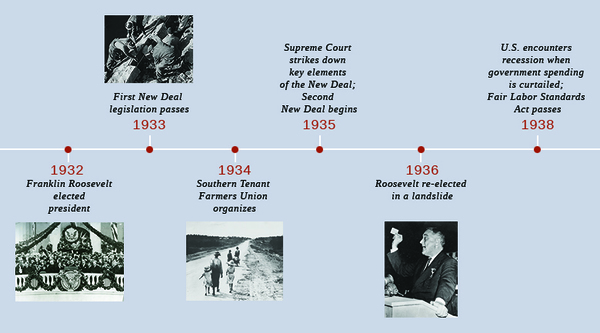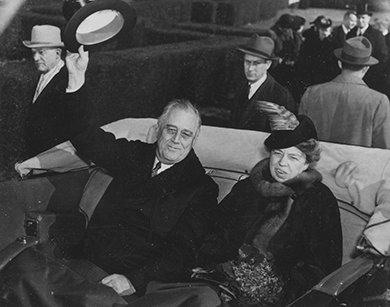| << Chapter < Page | Chapter >> Page > |

Franklin Roosevelt was part of the political establishment and the wealthy elite, but in the 1932 presidential campaign, he did not want to be perceived that way. Roosevelt felt that the country needed sweeping change, and he ran a campaign intended to convince the American people that he could deliver that change. It was not the specifics of his campaign promises that were different; in fact, he gave very few details and likely did not yet have a clear idea of how he would raise the country out of the Great Depression. But he campaigned tirelessly, talking to thousands of people, appearing at his party’s national convention, and striving to show the public that he was a different breed of politician. As Hoover grew more morose and physically unwell in the face of the campaign, Roosevelt thrived. He was elected in a landslide by a country ready for the change he had promised.
By the 1932 presidential election, Hoover’s popularity was at an all-time low. Despite his efforts to address the hardships that many Americans faced, his ineffectual response to the Great Depression left Americans angry and ready for change. Franklin Roosevelt, though born to wealth and educated at the best schools, offered the change people sought. His experience in politics had previously included a seat in the New York State legislature, a vice-presidential nomination, and a stint as governor of New York. During the latter, he introduced many state-level reforms that later formed the basis of his New Deal as well as worked with several advisors who later formed the Brains Trust that advised his federal agenda.
Roosevelt exuded confidence, which the American public desperately wished to see in their leader ( [link] ). And, despite his affluence, Americans felt that he could relate to their suffering due to his own physical hardships; he had been struck with polio a decade earlier and was essentially paralyzed from the waist down for the remainder of his life. Roosevelt understood that the public sympathized with his ailment; he likewise developed a genuine empathy for public suffering as a result of his illness. However, he never wanted to be photographed in his wheelchair or appear infirm in any way, for fear that the public’s sympathy would transform into concern over his physical ability to discharge the duties of the Oval Office.

Roosevelt also recognized the need to convey to the voting public that he was not simply another member of the political aristocracy. At a time when the country not only faced its most severe economic challenges to date, but Americans began to question some of the fundamental principles of capitalism and democracy, Roosevelt sought to show that he was different—that he could defy expectations—and through his actions could find creative solutions to address the nation’s problems while restoring public confidence in fundamental American values. As a result, he not only was the first presidential candidate to appear in person at a national political convention to accept his party’s nomination but also flew there through terrible weather from New York to Chicago in order to do so—a risky venture in what was still the early stages of flight as public transportation. At the Democratic National Convention in 1932, he coined the famous phrase: “I pledge myself to a new deal for the American people.” The New Deal did not yet exist, but to the American people, any positive and optimistic response to the Great Depression was a welcome one.

Notification Switch
Would you like to follow the 'U.s. history' conversation and receive update notifications?